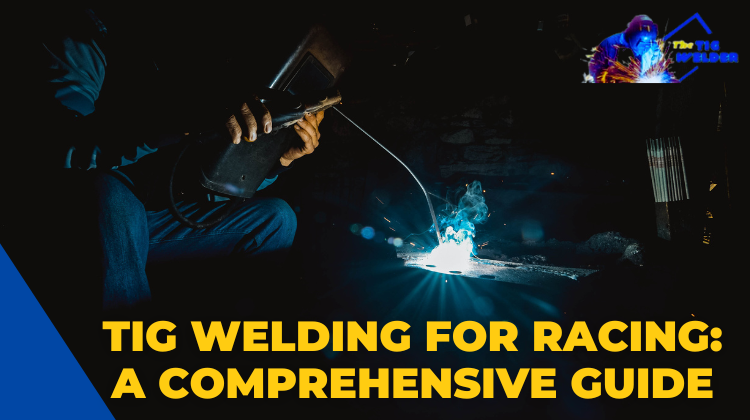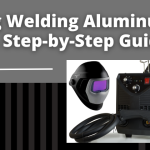TIG welding is essential for many racing applications, as it allows for strong, reliable welds on components subjected to high stresses and intense conditions. It is commonly used on exhaust systems, suspension components, roll cages, and other structural components of racing vehicles.
The TIG welding process involves heating the metal to be welded with an electric arc created between the tungsten electrode and the metal. Filler metal can be added to the weld pool to build the weld joint. A shielding gas, such as argon or helium, is also used to protect the weld pool and electrode from contamination.

Tig Welding for Racing
This comprehensive guide to tig welding for racing will provide all the necessary information and tips for those looking to improve their welding skills in this industry.
TIG Welding Equipment
To start TIG welding, you’ll need a machine capable of producing the correct amperage and voltage for the metal you are welding. It’s important to select a machine appropriate for the thickness and type of metal you will be working with.
The tungsten electrode is a crucial component of the TIG welding process. It is made of hard, refractory metal and is responsible for conducting the electric arc and creating the heat needed for welding. Different types of tungsten electrodes are available for different welding applications, so it’s important to choose the right one for your project.
Filler metal builds up the weld joint and adds strength to the weld. It is available in rod or wire form and comes in various materials, including steel, aluminum, and stainless steel. It’s important to select the appropriate filler metal for the welded metal and the intended application.
A gas tank and hose are also necessary for TIG welding. The shielding gas protects the weld pool and electrode from contamination, and a regulator on the gas tank typically controls the gas flow.
It’s also important to wear protective gear when TIG welding, including a welding helmet, gloves, and flame-resistant clothing.
Preparing for TIG Welding
Before starting the TIG welding process, it’s important to properly prepare the metal. This involves cleaning the metal to remove any dirt, oil, or other contaminants that could affect the quality of the weld. Grinding or sanding the metal’s edges can also create a clean, flat surface for the weld.
Setting up the welding machine involves selecting the correct amperage and voltage for the metal being welded and connecting the tungsten electrode and filler metal to the machine. It’s also important to set the gas flow rate to ensure that the weld pool is properly protected.
Choosing the correct filler metal is crucial for achieving a strong, reliable weld. It’s important to consider the type and thickness of the metal being welded and the intended application of the welded component.
Adjusting the gas flow is also important for achieving a high-quality weld. Too little gas can result in a contaminated weld, while too much gas can cause the weld pool to be too turbulent and result in a poor-quality weld.
TIG Welding Techniques
Several TIG welding techniques can be used to produce high-quality welds, each with its advantages and disadvantages.
The walking the cupping technique involves holding the tungsten electrode in one hand and the filler metal in the other and moving the tungsten along the weld joint while adding filler metal as needed. This technique is well-suited for welding thin materials and allows for precise control of the weld pool.
The pulsing technique rapidly switches the current on and off to control the heat input into the weld. This can help to reduce the risk of warping or distortion in the welded component.
The backhand technique involves welding in the opposite direction of the tungsten electrode, moving the electrode away from the weld pool as the weld progresses. This technique is often used for welding thicker materials or filling gaps in the weld joint.
The drag technique involves dragging the tungsten electrode along the weld joint, using the filler metal to create the weld pool. This technique is well-suited for welding in tight spaces or producing long, continuous welds.
TIG Welding Tips and Tricks
Proper hand positioning is crucial for achieving a high-quality TIG weld. The tungsten electrode should be held at a consistent angle, typically around 10-15 degrees, to ensure a consistent arc. The filler metal should be added to the weld pool at a similar angle to create a smooth, continuous bead.
Adjusting the amperage can also help to improve the quality of the weld. Too low of an amperage can result in a weak, porous weld, while too high of an amperage can cause the metal to melt too quickly and result in a poor-quality weld.
Controlling the heat is important in TIG welding, as excessive heat can cause the metal to warp or distort. One way to control the heat is by using the pulsing technique mentioned earlier, which allows for precise current control. Another option is to use a water-cooled torch, which helps to dissipate heat and reduce the risk of distortion.
Porosity, or small holes in the weld, can weaken the weld and reduce its reliability. To avoid porosity, it’s important to use a high-quality shielding gas and ensure that the weld joint is properly cleaned and prepped before welding.
TIG Welding on Racing Components
TIG welding is commonly used on racing components due to its precision and ability to produce strong, reliable welds. Some specific applications of TIG welding in racing include:
Welding exhaust systems: TIG welding is often used to fabricate custom exhaust systems for racing vehicles. It allows for precise control of the weld joint and produces high-quality welds that can withstand an exhaust system’s high temperatures and stresses.
Welding suspension components: TIG welding is also used to fabricate and repair suspension components, such as control arms and sway bars. The precision and strength of TIG welds make them ideal for these critical components.
Welding roll cages are an important safety feature of racing vehicles, and TIG welding is often used to fabricate and repair them. The strength and precision of TIG welds make them well-suited for this application.
What Welder Is Best For The Auto Body?
MIG (inert metal gas) welding, or GMAW, is a popular choice for auto body work due to its high welding speed and the ability to produce strong, high-quality welds. MIG welding is relatively easy to learn and can be used to weld various materials, including steel, stainless steel, and aluminum.
TIG welding is also a popular choice for auto body work due to its precision and the ability to produce high-quality welds with a smooth finish. TIG welding is more difficult to learn than MIG welding and is typically better suited for thin materials and precise, high-quality work.
Is It Better To use Mig Or Tig Body Panels?
MIG welding is generally faster and easier to learn than TIG welding and can be used to weld various materials, including steel, stainless steel, and aluminum. MIG welding is a good choice for high-production work and welding thicker materials.
TIG welding is a more precise and detailed process typically better suited for thin materials and high-quality work. TIG welding is more difficult to learn than MIG welding, but it can produce welds with a smooth finish and high precision.
What Is The Hardest Welder To Learn?
The difficulty of learning a specific welding process can vary depending on the individual welder and their experience and background. Some welding processes, such as inert tungsten gas (TIG) welding, can be more challenging to learn due to the need for precise control and attention to detail. TIG welding requires a skilled operator who can maintain a consistent arc and control the filler metal addition rate to produce high-quality welds.
Other welding processes, such as shielded metal arc welding (SMAW) or flux-cored arc welding (FCAW), may be easier to learn for some welders due to the relatively forgiving nature of these processes. However, these processes may need to be more precise and capable of producing high-quality welds like TIG welding.
What Is The Most Advanced Welding?
Each welding process is considered the least advanced, as the choice of welding process will depend on the specific needs of the project and the materials being used. Some welding processes, such as laser welding and electron beam welding, are considered more advanced due to their high levels of precision and the ability to weld a wide variety of materials. These processes are typically used for high-precision applications, such as in the aerospace or medical industries, where the highest level of weld quality is required.
Other welding processes, such as inert tungsten gas (TIG) welding and plasma arc welding, are also considered advanced due to their ability to produce high-quality welds with a smooth finish. These processes are commonly used for precision welding applications in various industries.
How Many Amps Does It Take To Weld Body Panels?
The number of amps required to weld body panels will depend on various factors, including the thickness of the materials being welded, the welding process being used, and the type of power source used.
For example, when using a MIG (inert metal gas) welder to weld body panels made of steel, a welding current in the range of 120-180 amps may be suitable for welding panels that are 18-gauge (1.2 mm) thick. For thicker materials, a higher welding current may be required.
When using a TIG (inert tungsten gas) welder to weld body panels, the welding current may be lower, typically in the range of 20-100 amps. The specific welding current required will depend on the thickness of the welded materials and the desired weld characteristics.
It is important to use the appropriate welding current for the specific materials and welding process to ensure the best possible weld quality and minimize the risk of overheating and damaging the materials being welded.
Conclusion
TIG welding is an essential process for many racing applications, as it allows for the production of strong, reliable welds on critical components. Proper equipment and technique are crucial for achieving high-quality welds, and it’s important to understand the various TIG welding techniques and tips for achieving the best results. By following these guidelines, you can confidently use TIG welding to fabricate and repair racing components and improve the performance and safety of your vehicle.

It’s been years since I got into welding as a side hustle. It’s been so long since Doing All kinds of welds for business and pleasure as this is my hobby. Being in this field I have learned from hands-on-experience also came to know what gears work and what doesn’t. The Tig Welder is my own platform where I use to share my experience.






Leave a Reply